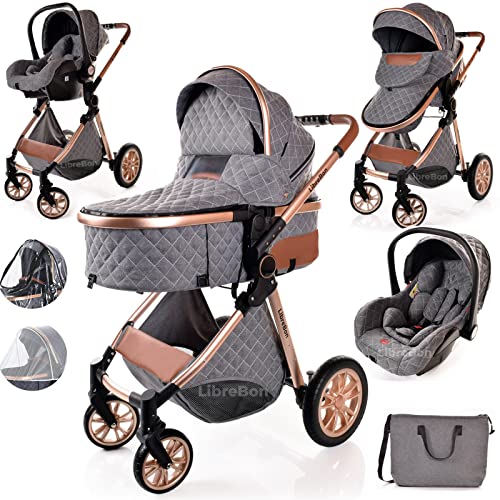The Three Greatest Moments In Prams For Newborn History
A Comprehensive Guide to Prams for Newborns
As a new moms and dad, selecting the suitable pram for your newborn can be a difficult job. With countless choices available on the market, each boasting distinct functions, it is vital to make an educated choice that matches your way of life and the needs of your little one. This post functions as a thorough guide to prams for newborns, helping moms and dads navigate through numerous choices, features, and precaution.
Understanding Prams
Prams, frequently referred to as carriages or pushchairs, are specially designed for transporting infants. Unlike strollers, prams are mostly meant for newborns and more youthful babies and come geared up with a flat, completely reclining seat. This style supports the baby's establishing spinal column and is appropriate for babies from birth up until they can stay up independently or reach a particular weight, typically around 6 to 12 months.
Types of Prams
There are various kinds of prams readily available for newborns, each with distinct qualities:
Traditional Prams
- Description: These have a classic style with a carrycot function that enables the baby to lie flat.
- Pros: Maximum comfort for babies and thought about stylish.
- Cons: Often bulky and not easily foldable.
Travel Systems
- Description: A combination bundle that typically includes a safety seat and a stroller that can be quickly interchanged.
- Pros: Convenient for transitioning from vehicle to pram, flexible, and space-efficient.
- Cons: The weight of combined systems can be a concern.
Convertible Prams
- Description: These can be changed from a pram to a stroller as the kid grows.
- Pros: Adaptable to the child's developmental phases and can be economical.
- Cons: May have more moving parts which could lead to toughness concerns.
Light-weight Prams
- Description: Compact and simple to steer, ideal for parents on the go.
- Pros: Easy to transport and keep, ideal for city living.
- Cons: May not offer as much comfort or storage area.
Table 1: Comparison of Pram Types
Pram Type
Convenience Level
Weight
Storage Space
Rate Range
Conventional Prams
High
Heavy
Minimal
₤ ₤ – ₤ ₤ ₤
Travel Systems
Moderate
Moderate to Heavy
Ample
₤ ₤ – ₤ ₤ ₤
Convertible Prams
High
Moderate to Heavy
Restricted
₤ ₤ – ₤ ₤ ₤
Lightweight Prams
Moderate
Light
Limited
₤ – ₤ ₤
Features to Consider
When selecting a pram for your newborn, think about the following features:
- Safety Harness: Ensure the pram has a safe harness system to keep your baby safe.
- Adjustable Handle Height: This is vital for convenience, particularly for taller or much shorter moms and dads.
- Sun Canopy: An excellent sun canopy safeguards the baby from UV rays.
- Suspension System: A pram with a suspension system provides a smoother ride over different surfaces, securing fragile bodies from disconcerting movements.
- Storage Basket: Consider a pram with a big storage basket for bring essentials such as diaper bags or groceries.
Prioritizing Safety
Safety is paramount when choosing a pram for a newborn. Here are some guidelines parents ought to follow:
Brakes: Always choose a pram with trustworthy brakes. Fixed brakes are ideal for stopping the pram on sloped surface areas.
Stability: Check the width and style of the pram base for stability to avoid tipping.
Material Safety: Ensure materials are non-toxic and devoid of harmful chemicals.
Age Suitability: Confirm the pram is appropriate for your baby's age and weight according to the producer's guidelines.
Frequently Asked Questions (FAQs)
Q: At what age can my baby start using a pram? Pushchairs And Prams : Newborns can utilize prams right from birth as long as they have a totally reclining feature. Q: Can I utilize a stroller rather of a pram for my newborn?A: While some strollers have a fully reclining seat appropriate for newborns, prams are suggested for higher comfort and security for very young infants. Q: Are travel systems worth the investment?A: For parents who desire an all-in-one service for transport, travel systems are extremely convenient as they save time and effort in transitioning in between vehicle and pram. Q: How do I clean and keep my pram?A: Regularly inspect the user manual for cleaning up recommendations. The majority of fabrics are detachable and device washable, while plastic parts can usually be cleaned
down with mild soap and water. Selecting the best pram for a newborn is a significant choice that involves examining numerous types and features while keeping security as the top concern.
By understanding the differences in between prams, considering essential functions, and sticking to safety standards, parents can make sure a comfy and protected ride for their kids. Ultimately, the best pram is one that aligns with the family's way of life, making sure that both parent and baby can enjoy outings together. 